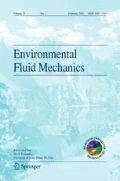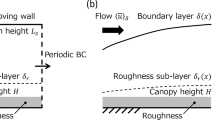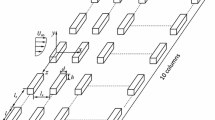Abstract
Turbulent flow in a densely built-up area of Seoul, South Korea, is numerically investigated using the parallelized large-eddy simulation model. Based on the analysis of streamwise velocity and column-averaged vertical turbulent momentum flux, three areas of interest are selected: a downstream area of an apartment complex, an area behind high-rise buildings, and a park area. In the downstream area of the apartment complex, a large wake develops and a region of strong vertical turbulent momentum flux appears above the wake. At the height of maximum vertical turbulent momentum flux magnitude, all the four quadrant events occur in larger magnitude and contribute more to the vertical turbulent momentum transport than the averages in the main domain. In the area behind the high-rise buildings, fluctuating wakes and vortices are distinct flow structures around the top of the tallest building and updrafts induced by the flow structures appear as strong ejections just behind the high-rise buildings or farther downstream. While strong ejections are dominant at building-top heights, downdrafts along the windward walls of high-rise buildings are distinct below building-top heights and they induce high turbulent kinetic energy and winding flow around the high-rise buildings near the ground surface, transporting momentum downward and intermittently into nearby streets. In the park area located downstream in the main domain, turbulent eddies exist well above the ground surface, and the thickness of the interfacial region between low-speed air and high-speed air increases and complex turbulent flow appears in the interfacial region.










Similar content being viewed by others
References
Coceal O, Dobre A, Thomas TG (2007) Unsteady dynamics and organized structures from DNS over an idealized building canopy. Int J Climatol 27:1943–1953
Cui Z, Cai XM, Baker CJ (2004) Large-eddy simulation of turbulent flow in a street canyon. Quart J R Meteor Soc 130:1373–1394
Deardorff JW (1980) Stratocumulus-capped mixed layers derived from a three-dimensional model. Bound Layer Meteor 18:495–527
Inagaki A, Kanda M (2010) Organized structure of active turbulence over an array of cubes within the logarithmic layer of atmospheric flow. Bound Layer Meteor 135:209–228
Inagaki A, Castillo MCL, Yamashita Y, Kanda M, Takimoto H (2012) Large-eddy simulation of coherent flow structures within a cubical canopy. Bound Layer Meteor 142:207–222
Kanda M, Moriwaki R, Kasamatsu F (2004) Large-eddy simulation of turbulent organized structures within and above explicitly resolved cube arrays. Bound Layer Meteor 112:343–368
Kanda M (2006) Large-eddy simulations on the effects of surface geometry of building arrays on turbulent organized structures. Bound Layer Meteor 118:151–168
Kataoka H, Mizuno M (2002) Numerical flow computation around aeroelastic 3D square cylinder using inflow turbulence. Wind Struct 5:379–392
Letzel MO, Krane M, Raasch S (2008) High resolution urban large-eddy simulation studies from street canyon to neighbourhood scale. Atmos Environ 42:8770–8784
Letzel MO, Helmke C, Ng E, An X, Lai A, Raasch S (2012) LES case study on pedestrian level ventilation in two neighbourhoods in Hong Kong. Meteor Z 21:575–589
Louka P, Vachon G, Sini JF, Mestayer PG, Rosant JM (2002) Thermal effects on the airflow in a street canyon—Nantes’99 experimental results and model simulations. Water Air Soil Pollut F 2:351–364
Lund TS, Wu X, Squires KD (1998) Generation of turbulent inflow data for spatially-developing boundary layer simulations. J Comput Phys 140:233–258
Nakayama H, Takemi T, Nagai H (2011) LES analysis of the aerodynamic surface properties for turbulent flows over building arrays with various geometries. J Appl Meteor Climatol 50:1692–1712
Nakayama H, Takemi T, Nagai H (2012) Large-eddy simulation of urban boundary-layer flows by generating turbulent inflows from mesoscale meteorological simulations. Atmos Sci Lett 13:180–186
Park SB, Baik JJ, Raasch S, Letzel MO (2012) A large-eddy simulation study of thermal effects on turbulent flow and dispersion in and above a street canyon. J Appl Meteor Climatol 51:829–841
Park SB, Baik JJ (2013) A large-eddy simulation study of thermal effects on turbulence coherent structures in and above a building array. J Appl Meteor Climatol 52:1348–1365
Piacsek SA, Williams GP (1970) Conservation properties of convection difference schemes. J Comput Phys 6:392–405
Raasch S, Schröter M (2001) PALM—a large-eddy simulation model performing on massively parallel computers. Meteor Z 10:363–372
Raupach MR (1981) Conditional statistics of Reynolds stress in rough-wall and smooth-wall turbulent boundary layers. J Fluid Mech 108:363–382
Raupach MR, Finnigan JJ, Brunet Y (1996) Coherent eddies and turbulence in vegetation canopies: the mixing-layer analogy. Bound Layer Meteor 78:351–382
Rotach MW (1993) Turbulence close to a rough urban surface, part I: Reynolds stress. Bound Layer Meteor 65:1–28
Watanabe T (2004) Large-eddy simulation of coherent turbulence structures associated with scalar ramps over plant canopies. Bound Layer Meteor 112:307–341
Xie ZT, Coceal O, Castro IP (2008) Large-eddy simulation of flows over random urban-like obstacles. Bound Layer Meteor 129:1–23
Xie ZT (2011) Modelling street-scale flow and dispersion in realistic winds—towards coupling with mesoscale meteorological models. Bound Layer Meteor 141:53–75
Acknowledgments
The authors thank two anonymous reviewers for providing valuable comments on this work. This work was supported by the National Research Foundation of Korea (NRF) grant funded by the Korea Ministry of Education, Science and Technology (MEST) (No. 2012-0005674) and also supported by the Brain Korea 21 Project (through the School of Earth and Environmental Sciences, Seoul National University).
Author information
Authors and Affiliations
Corresponding author
Rights and permissions
About this article
Cite this article
Park, SB., Baik, JJ. & Han, BS. Large-eddy simulation of turbulent flow in a densely built-up urban area. Environ Fluid Mech 15, 235–250 (2015). https://doi.org/10.1007/s10652-013-9306-3
Received:
Accepted:
Published:
Issue Date:
DOI: https://doi.org/10.1007/s10652-013-9306-3




